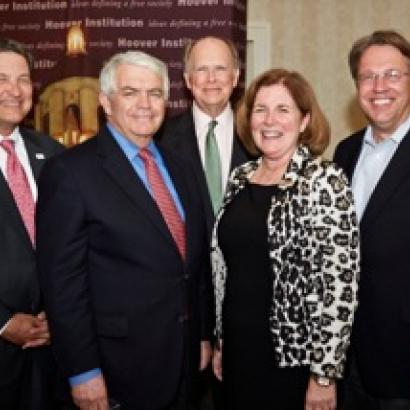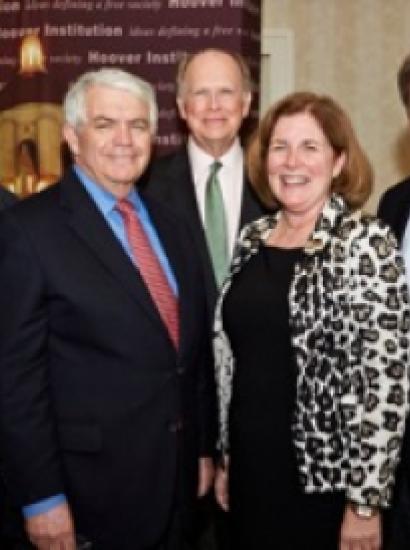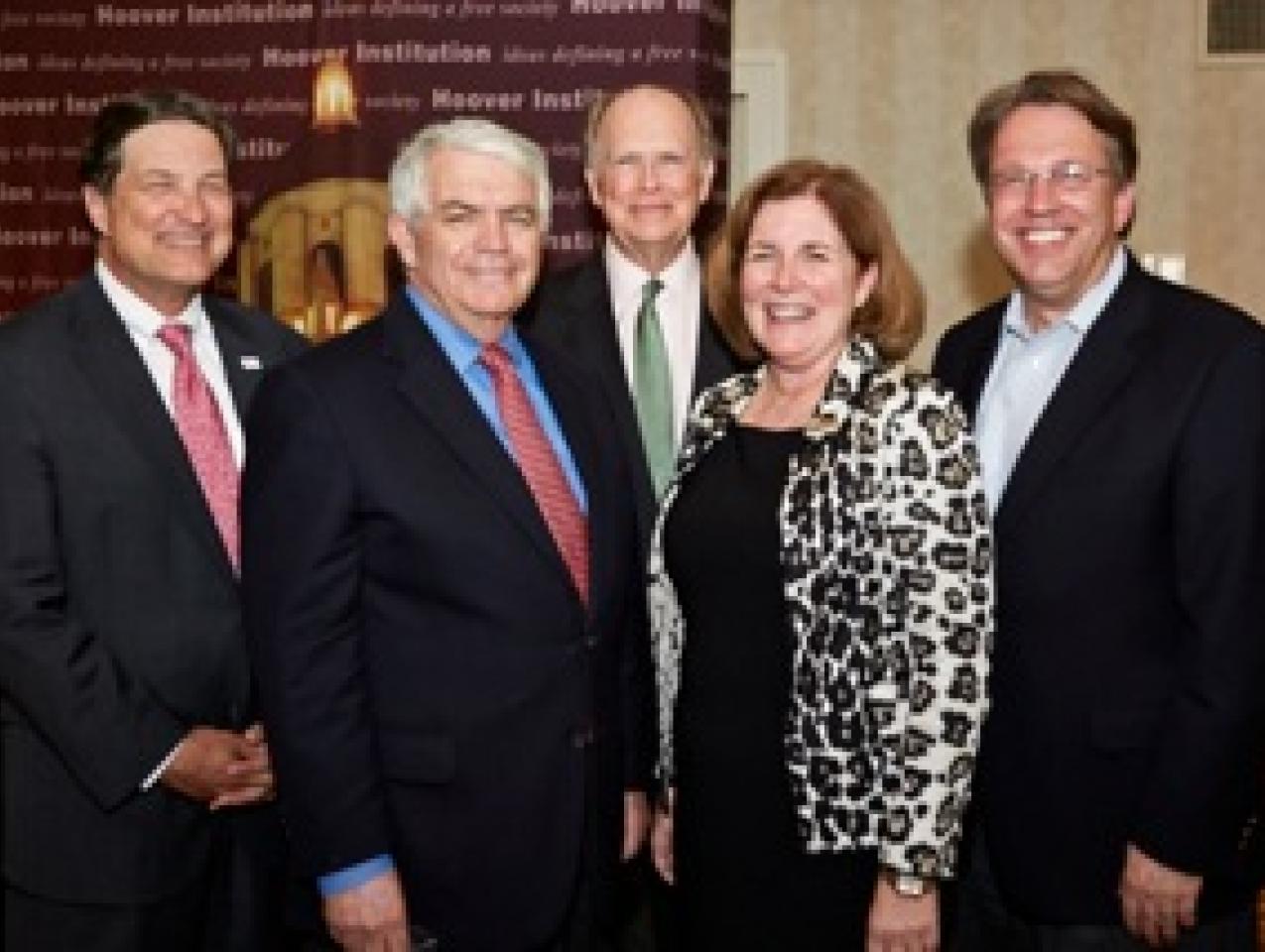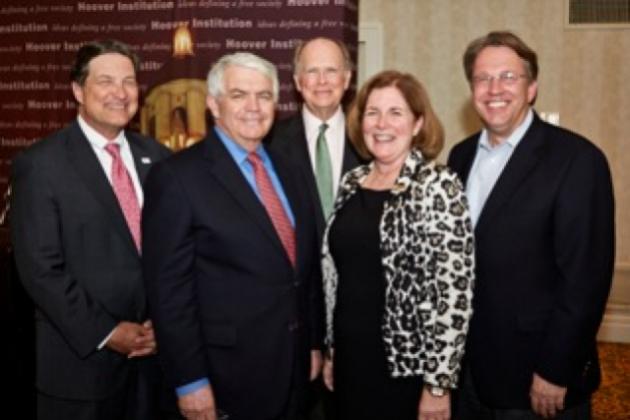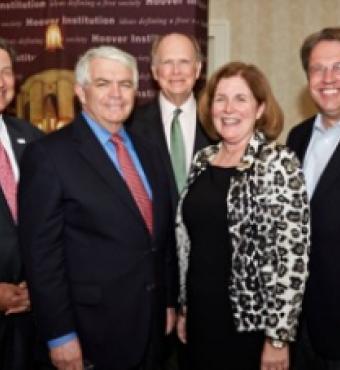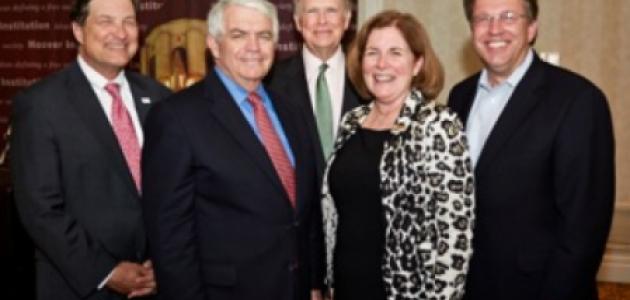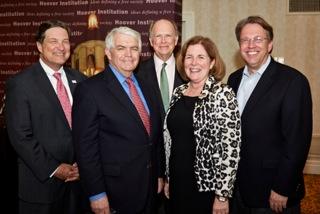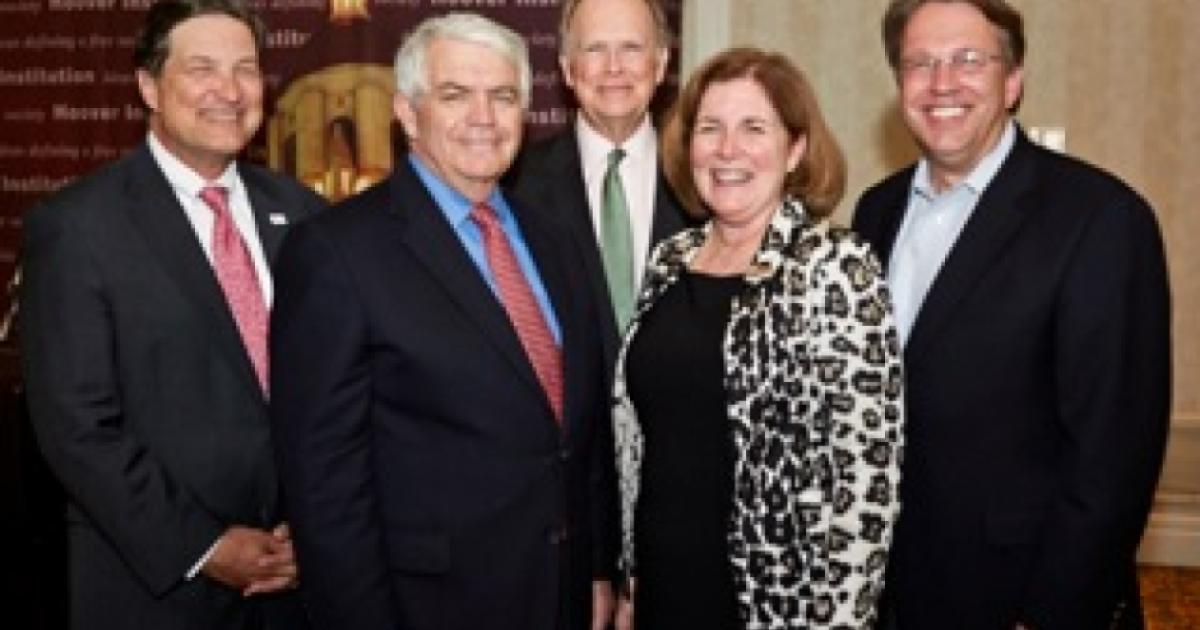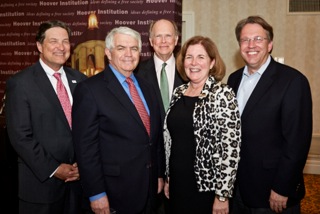
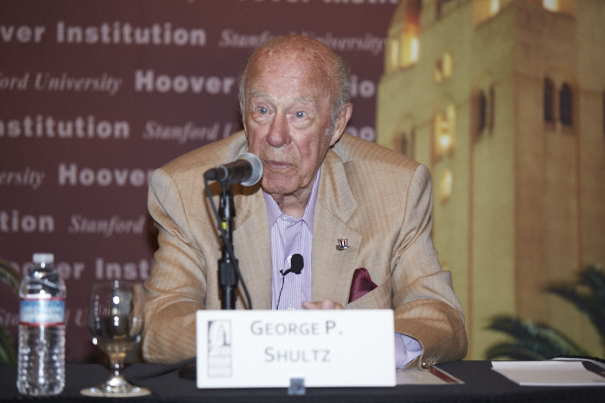
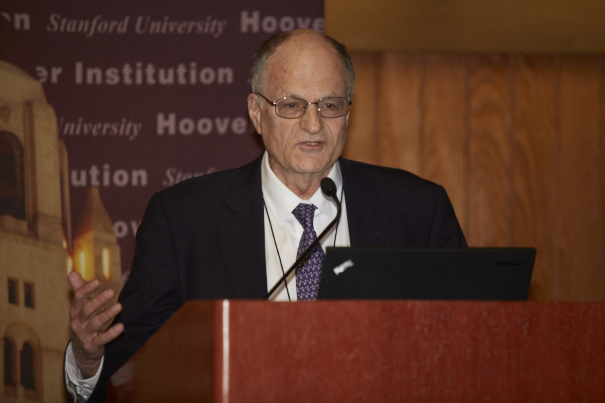
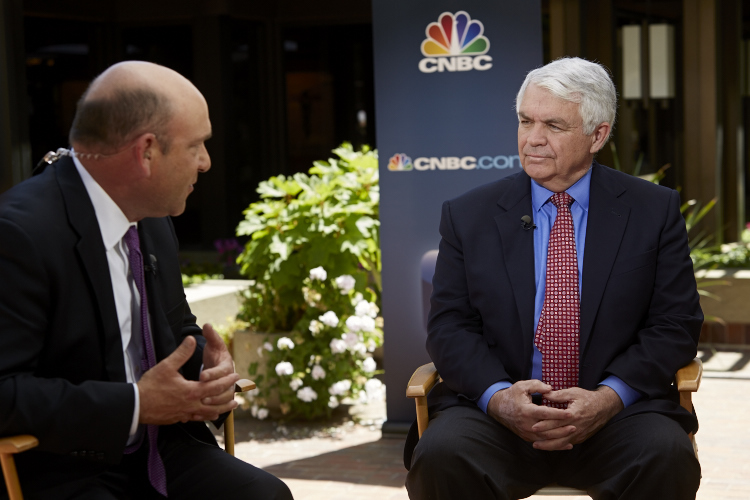
Four Fed presidents, distinguished economists, and a large media presence signaled the first day of the Conference on Frameworks for Central Banking in the Next Century, organized by Hoover senior fellow John B. Taylor. As stated by Taylor in his opening remarks, the purpose of the conference is to “put forth and discuss a set of policy recommendations that are consistent with and encourage a more rules-based policy for the Federal Reserve and would thus improve economic performance, especially in comparison with the past decade.” The conference features many leading economic minds participating in two panel discussions and seven paper discussions over the course of two days.
Click here to see the first day summary; click here to see the second day summary; and click resources to see news coverage and additional resources.
The conference opened with a discussion by Edward Prescott on Hoover senior fellow John Cochrane’s paper “Monetary Policy with Interest on Reserves.” Cochrane’s argument, in a vast departure from standard monetary policy, promoted an interest on reserves (IOR) monetary policy regime. Cochrane believes we should embrace the Federal Reserve’s large balance sheet in conjunction with an IOR regime because it would yield a more stable financial system. In doing so, Cochrane challenges the accepted doctrine of monetary policy. He claims that a revamped monetary policy is required in response to the unprecedented actions of the Federal Reserve in the past few years. As a result of the Fed’s actions and the advancement of communication technologies, economists need to rethink their answers to fundamental questions such as the determination of inflation or the Fed’s ability to control real or nominal interest rates, a regime that would dramatically alter the role of central banks. This argument sparked a discussion of the policy tools available to central banks to resolve financial crises and the effects of those policy tools.
Following Papell was Athanasios Orphanides’s discussion of Marvin Goodfriend’s paper “Lessons from a Century of Fed Policy: Why Monetary and Credit Policies Need Rules and Boundaries.” Goodfriend argues that the Fed’s inclination to prioritize low unemployment over low inflation produced an ineffective go-stop monetary policy after the Second World War, resulting in the Great Inflation. The Volcker Fed disinflation in the early 1980s demonstrated the need for an interest-rate rule based on a credible commitment to low inflation. He went on to argue that the Fed’s track record with credit policy is equally problematic, beginning with the gradual relaxation of the Fed’s last-resort lending discipline since the Second World War and ending with the Fed’s massive expansion of credit in the 2007-9 credit turmoil. Goodfriend concludes that, similar to monetary policy, the Fed would benefit from a more tightly disciplined and independent credit policy.Next was Hoover affiliate and Stanford economics professor Monika Piazzesi discussing David Papell’s paper “Deviations from Rules-Based Policy and Their Effects.” The paper defines eras of monetary policy as rules-based or discretionary in terms of three versions of the Taylor rule-- original, modified, and estimated–using tests for multiple structural changes. Invoking those newly defined eras, the paper then tests economic performance from various loss functions, finding that economic performance is uniformly better during rules-based eras and that the original Taylor rule is associated with the highest economic performance.
The day’s presentations ended with a panel chaired by Hoover distinguished visiting fellow Michael Bordo and featuring Hoover senior fellow Niall Ferguson, Barry Eichengreen, and Hoover distinguished visiting fellow Allan Meltzer discussing the topic “Methodology of Economic History for Evaluating Monetary Policy.” Ferguson began by emphasizing the efficacy of policies and arguing that fiscal deficits, expensive balance sheets, and compromised Fed independence are factors contributing to the monetary problems. Eichengreen continued by arguing that economic historians place more emphasis on context and institutions than on monetary policy efficacy. Finally, Meltzer provided his historiography of the Fed’s “independence,” arguing that the Fed is independent within the government but not of the government. The ensuing discussion again underlined the need for rules-based policies, for both monetary policy and fiscal policy.
The first day ended with dinner remarks by Esther George, the president of the Federal Reserve Bank of Kansas City, arguing that “promoting financial stability requires a comprehensive approach that uses both macroprudential tools and the examination of individual firms, relying on the judgment of experienced examiners.” She began with a discussion of the relationship between incentives, policy making, and financial stability, emphasizing the need for gradual reforms in her policy prescriptions. She continued with her suggestions for how bank supervisors can have a comprehensive response to the financial problems of the current environment, “blend[ing] the new quantitative macrosupervisory approaches with the qualitative judgments that supervisors bring from examining individual firms.” She ended with a discussion of how her recommended comprehensive response would achieve financial stability.
The second day began with a presentation by Martin Schneider on Hoover senior fellow Lee Ohanian’s paper entitled “Monetary Policy in the Midst of Big Shocks.” Ohanian studied the impact of the largest deviations from price stability during the Fed’s first century, with an emphasis on the post-First World War period in the 1920s, the Great Depression, the Second World War, and the Stagflation of the 1970s. For the first two periods, he found that deflation in the early 1920s did not depress the economy nearly as much as in the 1930s. For the third period, he found that the biggest impact of monetary policy during the Second World War was in debasing debt through inflation, which was achieved without much impact to the Fed’s credibility. For the last period, he found that the Fed could have done little to intervene in the 1970s becausethe economy was primarily driven by long-run changes in productivity and the labor market. His paper sparked a discussion of wage systems and labor incentives.
Following Ohanian’s paper discussion was a presentation by Otmar Issing on Andrew Levin’s paper “The Design and Communication of Systematic Monetary Policy Strategies.” Levin argued that the strategy for improving monetary policy is closely related to the need to improve communication from central banking organizations. He then provided some principles for monetary policy communication, coupled with some objectives for a central bank. This discussion emphasized the need again for clear and predictable rules because these would be explainable and reserve defenses when more complicated rationalization is required.
Next, Jeff Lacker presented Hoover distinguished visiting fellow Michael Bordo’s paper “Rules for a Lender of Last Resort: A Historical Perspective.” Bordo described how the Fed evolved as a lender of last resort in the twentieth century, beginning with the financial crash in 1929 and ending with the Dodd Frank Act in 2010. Using this historical perspective, Bordo argued that the Fed’s actions in the recent crisis allayed financial disaster but that the policies following the crisis have created new problems. His historiography includes comparing how the Fed had improved its response for the most recent crisis against having created the roots for this crisis and future crises.
In the afternoon, Maurice Obstfeld presented Richard Clarida’s paper “Monetary Policy in Open Economies: Practical Perspective for Pragmatic Central Bankers.” In this paper, using an aggregating economic model, Clarida interpreted key policy implications for monetary policy in an open economy. He found that good macroeconomic outcomes in open economies are possible by focusing on inflation targeting as implemented by the Taylor rule (or a similar method). He also discussed the limits of monetary policy, such as the ability to maintain a stationary nominal exchange rate, or cointegrated home, and foreign domestic price levels. He ended his discussion by defending the Taylor rule against a convoluted result from his model that could be interpreted as a critique of policies based on such rules.
To end the conference, Hoover distinguished fellow George Shultz led a panel discussion on “Rules-Based Policy: From Theory to Practice,” featuring Charles Plosser, Hoover senior fellow Thomas Sargent, and John Williams. All their remarks emphasized the theme of more transparent and predictable practices for central banking–a fitting end to the two days.
To learn more about the conference, see the posted agenda on the Hoover website, where many of the presenters’ papers are posted; see the Twitter conversation for the thoughts of conference participants; and see the coverage of the conference from other news outlets:
- Stanford News
- Wall Street Journal (subscription may be required)
- John Taylor: Interest Rates Should Already Be Higher
- Fed Officials Downplay Financial Stability Concerns
- Fed’s Plosser: Fed Should Adopt More Formal Policy Rule
- Fed’s Policy Hawks Express Mix of Views on Timing of Rate Hikes
- Grand Central: KC Fed’s George Sets Battle Lines on Rate Hikes
- Esther George Says Fed Should Begin Rate Hikes ‘Shortly’ After Bond Buys End
- Fed Ignores Policy Rules at Own Peril, Paper Finds
- New York Times
- Financial Times
- Washington Post:
- Bloomberg News:
- John Taylor on Bloomberg Radio
- Niall Ferguson on Bloomberg Radio
- Charles Plosser on Bloomberg Radio
- Michael Bordo and Hoover research fellow Tim Kane on Bloomberg Radio
- Cameron Teitelman, founder of non-profit StartX), on Bloomberg Radio
- Michael Cuggino, president of the Permanent Portfolio family of funds, on Bloomberg Radio
- David Pappel on Bloomberg Radio
- Reuters:
- Fed officials say rates should not be used to fight bubbles
- DIARY – Top Economic Events to June 12
- Fed’s George wants rate hikes soon, and not too gradual
- Lacker warns on Fed’s role in credit markets
- Fed’s Plosser floats new approach to forward guidance on rates
- U.S. Fed’s George says open to big balance sheet
- U.S. Fed can’t fight inflation on its own, economist says
- What to Watch in The Day Ahead; Friday, May 30
- Fed’s Lacker says Q2 rate lift off next year “plausible”-CNBC
- Market News International:
- Economic Principles







